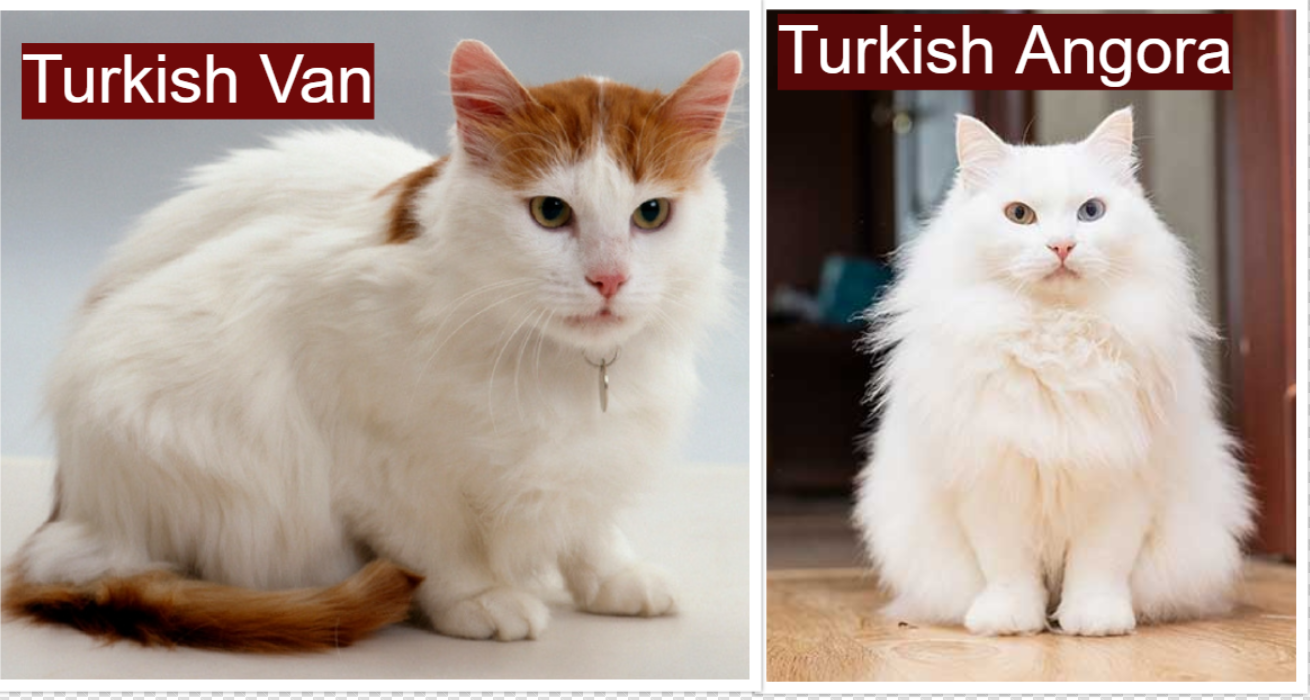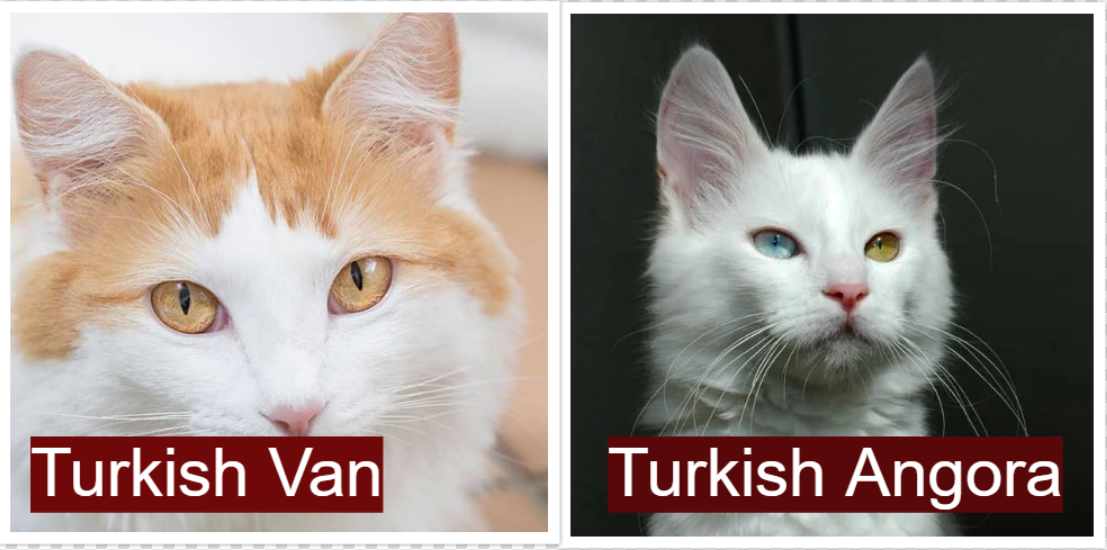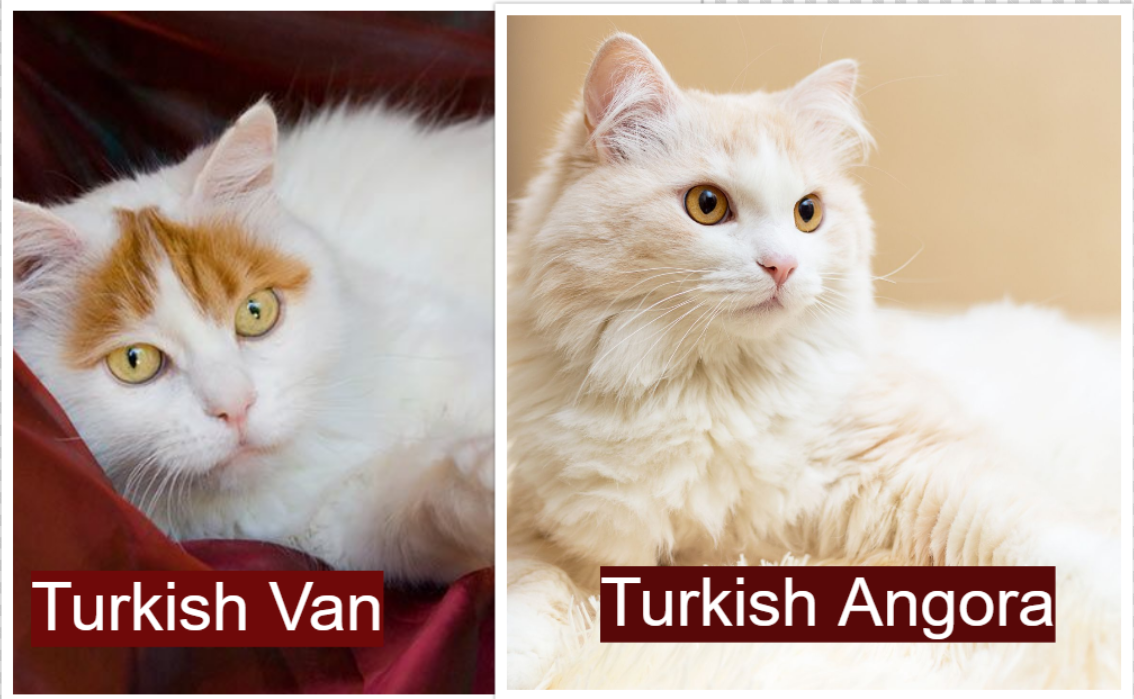How do you know if your cat is a Turkish Van or Turkish Angora, given that both breeds are predominantly white in color? Consequently, determining whether a cat is a Turkish Van or Turkish Angora requires careful observation and consideration of various physical characteristics.
Turkish Van vs Turkish Angora Coat
The Turkish Van boasts a lustrous white coat that rivals the softness of cashmere. As the summer heat sets in, this majestic feline sheds its hair, revealing a shorter and lighter coat. However, when winter arrives, the Turkish Van's coat transforms into a thick and luxuriously long white mane, exuding elegance and grace.
In contrast, the Turkish Angora dons a captivating coat that is not only long but also incredibly soft. This breed showcases a remarkable array of colors and variations, adding to its allure. While white remains the traditional and widely favored hue, it is worth noting that the Ankara Zoo exclusively produces this shade. However, Turkish Angoras can be found in an enchanting palette of black, reds, browns, and grays, as well as captivating tabby, tortoiseshell, and bicolor variations.
Although all-white Turkish vans do exist, they are not deemed to possess show quality and are consequently intentionally bred out. What distinguishes the Turkish van is its unique van pattern of coloration: a predominantly white body adorned with distinctively colored spots on their heads, complemented by a typically solid-colored tail of the same hue, as specified by the breed standard.
Turkish Van vs Turkish Angora Tail
In order to discern between a Turkish Van and a Turkish Angora cat, one can meticulously observe the characteristics of their tails. A Turkish Van cat boasts a luxuriant, brush-like tail that is not only abundant but also exhibits a captivating coloration. For instance, the tail of a Turkish Van may present shades of brown, red, gray, or black, creating a striking contrast against its pristine white coat.
Conversely, Turkish Angoras are renowned for their immaculate all-white tails, which are typically long, delicate, and voluminous in nature. However, it is worth noting that Turkish Angoras can also exhibit a captivating array of colors and variations, including black, blue, red, tabby, tabby-white, lavender, and cinnamon.
Turkish Van vs Turkish Angora Ears
When it comes to Turkish Angoras, their ears are a striking feature, characterized by their pointed shape, large size, and wide-set position. These elegant felines are known for their ability to display a wide range of colors. On the other hand, Turkish Vans boast ears that match the color of their tail, which can be brown, red, gray, or black. These distinct markings create a captivating contrast against their pristine white coat. In some cases, Turkish Vans may exhibit a striped pattern on their ears, while in others, these markings may appear in a more solid configuration.
Turkish Van vs Turkish Angora Eyes
Turkish Vans boast eyes that are truly distinctive. While the majority of Turkish Vans enchant us with their mesmerizing blue eyes, there are those adorned with striking gold eyes. Moreover, it is not uncommon to encounter a Turkish Van with one eye of each color, a truly unique and enchanting sight.
On the other hand, Turkish Angoras, too, possess eyes that are a sight to behold. Their eyes come in a variety of captivating hues, ranging from the serene blues to the vibrant greens, the warm ambers, and even the enchanting yellows. What's more, some Turkish Angoras possess heterochromatic eyes, a phenomenon that adds an extra touch of mystique to their already captivating gaze. These feline beauties boast almond-shaped eyes, further enhancing their elegance and grace.
Turkish Van vs Turkish Angora Head Shape
When it comes to differentiating between the Turkish Van and the Turkish Angora, their head shapes play a crucial role. The Turkish Van boasts a truly distinctive head shape, characterized by its broad and wedge-shaped structure. Additionally, this feline possesses a charmingly rounded muzzle. On the contrary, the Turkish Angora showcases a smaller to medium-sized head, also taking on a wedge-like appearance. Its nose, of moderate length, gracefully curves, while the head tapers towards the chin.
Turkish Van vs Turkish Angora Size
When comparing the size of Turkish Van and Turkish Angora cats, there are a few notable differences to consider. Both breeds exhibit graceful and slender physiques, but the Turkish Van tends to be larger overall. In terms of height, Turkish Vans stand at around 10 to 14 inches at the shoulder, whereas Turkish Angoras are slightly smaller, measuring around 9-13 inches. Lengthwise, Turkish Vans can reach up to 3 feet from head to tail tip, while Turkish Angoras typically measure between 14-16 inches.
These disparities in height and length contribute to their varying weights as well. While Turkish Vans weigh between 12-20 pounds on average, sometimes even more for males, Turkish Angoras tend to weigh slightly less at approximately 8-15 pounds. It is important to note that these numbers may vary depending on factors such as gender, genetics, and overall health.
Turkish Van vs Turkish Angora Behavior
The Turkish Van is known for its active and energetic nature, often displaying a strong urge to explore and play. These cats are adventurous and love water, enjoying the opportunity to swim or splash in shallow pools. They are also sociable creatures, forming strong bonds with their owners and eagerly seeking attention and affection.
On the other hand, Turkish Angoras are renowned for their playful nature, exceptional intelligence, athletic prowess, and high level of engagement. They are known for their lively nature and their tendency to seek elevated positions within the household. These vantage points serve as ideal observation posts, allowing them to closely monitor the activities taking place in their surroundings.
You may find them perched atop doors, refrigerators, bookshelves, or other pieces of furniture. Some even enjoy riding on their owners' shoulders, showcasing their playful and affectionate disposition. Moreover, Turkish Angoras generally thrive in households with other animals or children, as well as in homes with a bustling atmosphere.
Turkish Vans, on the other hand, exhibit a strong preference for the company of their fellow Turkish Vans when placed in a multi-cat household. In general, both Turkish Van and Angora cats possess remarkable intelligence and a genuine inclination to engage with humans, making them highly trainable companions.
Conclusion
In order to accurately discern whether your cat is a Turkish Van or a Turkish Angora, it is essential to observe the key physical attributes and behavioral traits that I have mentioned above. Firstly, examine the coat texture and coloration. Turkish Vans have semi-long fur with a distinctive pattern known as "Van markings," which typically features a solid-colored back with colored patches on the head and tail – most commonly red or black. In contrast, Turkish Angoras possess long, silky fur that often comes in pure white but can also be found in various colors and patterns.
Secondly, consider their body structure; Turkish Vans are known for their powerfully built bodies with broad shoulders and muscular torsos, while Turkish Angoras display a more refined frame with a slender build overall.
Finally, assess their personalities; while both breeds are generally affectionate and intelligent, Turkish Vans tend to be more active and playful compared to the elegant yet relatively reserved Turkish Angoras. By carefully examining these characteristics, you will be able to differentiate between the two breeds and ascertain the true identity of your beloved feline companion.









